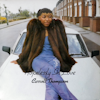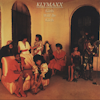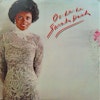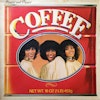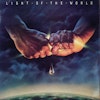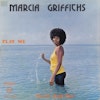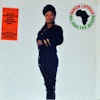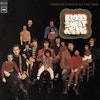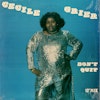In March 2013, Hiatus Kaiyote walked onto a New York City stage to greet a room so packed that latecomers could hardly squeeze their way through the door. Fans—some of whom had contributed their own money to a successful crowdsourcing campaign to get the four-piece out from Australia—sang along with open-mouthed enthusiasm, heads nodding to every beat as if willing the band to keep playing.
Similar scenes played out some nights earlier at their South by Southwest performances as well as solo shows in both D.C. and Chicago. The night after NYC, it would happen in Los Angeles too. People were so giddy with the thrill of discovering new music that Hiatus Kaiyote ended up selling out every date on their first U.S. tour. The remarkable thing about this was that, to date, they haven’t even released a debut album.
Few bands over the past couple of years have been surrounded by as much escalating chatter as Hiatus Kaiyote. Fronted by the joyously untamable twenty-four-year-old spirit Nai Palm, the Melbourne-based electronic soul group, rounded out by Simon Mavin (keys), Paul Bender (bass/production), and Perrin Moss (drums/production), has the knack of taking complex ideas and laying them out in a way that’s easy for listeners to absorb. Hiatus’s intricate arrangements are guided by a loose pop structure, and with a vibe similar to Little Dragon, the group herds fans through technically challenging compositions without losing that overarching emotional connection.
This balance between head and heart is what initially attracted Taylor McFerrin, one of the band’s earliest champions, to their music. He first came across Hiatus when they were opening for him in Melbourne about a year and a half ago. “I was just completely blown away,” he tells Wax Poetics. The group’s ability to plant complex arrangements into a left-field pop framework moved him to the point that he felt compelled to spread their music beyond their hometown bubble.
“I’d never really felt the urge to really try to help a band out, but I just have a lot of good friends in the DJ community that I knew I could send their music to,” McFerrin explains. He passed some tracks to Gilles Peterson and a few DJs at Los Angeles station KCRW, who in turn became enraptured with Hiatus’s sound and seeded their music even further.
The songs that McFerrin shared were lifted from Hiatus’s then forthcoming EP Tawk Tomahawk, which the band ended up self-releasing via Bandcamp in April 2012. The ten-track future-soul album is laced with jazz and hip-hop flourishes that introduce Hiatus Kaiyote by way of interludes connecting to fully formed songs.
Aside from the lush instrumentation, it’s Nai’s remarkable voice trending simultaneously towards sweet and strong that stitches Tawk Tomahawk together. While she writes abstractly, her raw delivery on the last track “Nakamarra” comes directly from the heart, making it relatable through feeling and positions it as the EP’s standout single. It also happens to be the track that Erykah Badu cosigned to the world via Twitter a few months later, with a simple “Okay. I’m done. In love,” and a link to the video. (More recently, she one-upped that declaration and tweeted that it was her favorite song.)
This wasn’t the first time a respected musician had gushed about the band either. A couple of weeks prior to Erykah’s outpouring of adoration, Questlove had already shared praise for Hiatus Kaiyote. Soon the band also heard that they could count Animal Collective and Dirty Projectors as fans. “I’ve never really seen the buzz around a band build this quick,” McFerrin laughs.
“The kind of freedom that gives you—validation from your idols to keep exploring—it’s amazing,” Nai says via a group Skype session at Perrin’s house, cradling a cup of tea in her hands. “It pushes you to do it even more.”
Melbourne is Australia’s second-largest city, with a population of just over four million. It boasts the strongest live music scene in the country, with a very active community of musicians working to play and release music independently. A large portion of this output speaks to Australia’s traditional rock-based trajectory, which is partly what makes Hiatus Kaiyote and its members interesting as somewhat of an outlier.
The way the group came together and the events that unfolded after their union have been punctuated by a combination of good fortune and good timing. “I think the Radiohead song ‘Everything in Its Right Place’ genuinely sums up our entire career,” Nai laughs.
A few years ago, Bender saw Nai performing solo on a pink, nylon-string Yamaha guitar in Melbourne, and he became excited enough about the idea of tinkering with her songs that he slid her a business card. They didn’t reconnect until after Nai had met Perrin in a café and sang him a loose version of “Lace Skull,” to which the producer-turned-drummer started unconsciously tapping along on his seat.
Simon, a longtime session musician who has played keys with some of Australia’s most reputable soul, funk, and jazz bands, was the final addition. He and Nai had never met before their first jam session, and although he, Bender, and Perrin had been living together for six months prior, he didn’t even initially realize that his housemate played the drums.
“There was a house party down the road, and I was walking down the alley to get to the party, and I heard this drummer playing,” Simon recounts. “I was just like, ‘Who the fuck is that? It sounds incredible!’ And I popped my head in, and there’s fuckin’ Perrin on the drums.”
All four members recount feeling something extraordinary from the first time they sat down together to play. As Nai’s first band, Perrin’s first in the capacity as drummer, and Simon’s first where he feels he has complete creative input, the band has matured at a hurtling rate since they officially committed to each other in mid-2011.

The group’s chemistry comes from a mix of intuitive and institutional knowledge. Self-taught musicians, Nai and Perrin were both raised on a varied diet of music. From the time when Nai was in the womb, the singer’s mother raised her against a backdrop of soul with elements of flamenco and world music thrown in. Perrin, while growing up, was heavily exposed to African rhythms. They both cultivated their musical intelligence through absorption of sound, studying by listening and developing their ear.
Simon and Bender mirror their bandmates by offering technical nous built up through years of formal training. The two sides inform each other, creating a balance between what works because theory dictates that it will, and what works even though, on paper, it shouldn’t.
The quartet in part attributes their rapid progress to the way they lock together creatively. “We’re all blessed to have a very similar vision—that’s what’s rare,” Nai says. “It’s so malleable and intangible that you can’t explain it, but we know that we have so much trust in everybody’s ideas that when you put your ego aside and fuse it together, it’s usually beyond what any of us could expect to reach just by ourselves.”
You can hear this cohesiveness in Hiatus’s songs, as the group musically moves and breathes together. Their approach is to treat the collective like a living organism, and as each member grows and evolves, so too does the band and its output. Nai initially brought skeletons of songs to her bandmates to be fleshed out, but the songwriting process has become increasingly more collaborative as the members settled into their creative relationships.
Hiatus’s music has subsequently been colored with more complexities as they’ve moved along. The tracks presented on Tawk Tomahawk still demonstrate a playful ability to build on a standard song structure, but the band’s more recent work speaks to the way they have begun to write with each other in mind.
At the time of writing, the band was waiting for the final touches to be put on a studio that they’re building at Bender and Simon’s house (which they also share with Hiatus’s sound engineer) before sitting down to record anything for their imminent debut LP. What they do have though is nearly two albums’ worth of material that they already play live that needs to be documented in a studio setting.
“We’ve definitely got an idea of our live sound and our studio sound,” Simon says. “I think seeing a difference between the two is a very important thing for us.” For this forthcoming release, the band’s aim is to unite both of these by capturing their live energy, one of Hiatus’s most remarkable features (boosted by a three-piece backing vocal section), and infusing it with the sonic textures that production brings to the recorded work as well.
“I have way more experience actually producing than playing, and that first record was a lot of half-playing, half-production stuff. I think this next record’s going to be a bit more the other way around,” Perrin says. “Certainly, there’ll be heaps of production, but it’s not going to be reliant on that as much. I think we’re going to push our own sound dispositions and record those ideas on our instruments and then produce on top of that.”
In the meantime, the band has amassed a collection of thoughts and diagrams jotted down on napkins, mapping out the direction of the as-yet untitled LP. The group approaches the album format in its traditional sense, monitoring the overall flow from one song to the next, rather than in the piecemeal iTunes, pick-and-mix style.
Also to be considered is the content of the songs themselves. Nai’s lyrical dexterity comes from intentionally leaving things open-ended, so her listeners can fill Hiatus’s songs with their own meanings.
“I think we’re all really conscious of the creative process of how you perceive something,” Nai explains. “It takes creativity to write something and to make something, but that’s only [when] you’re meeting people halfway. How somebody perceives something involves their creativity, because everybody’s coming from different walks of life. So I feel like we try and make it somewhat accessible in that kind of way.”
In this current digital climate, it’s become less astonishing that an Australian band is playing soul music so far from the source. Hiatus’s physical location, however, does help them interpret the genre differently than their peers living elsewhere.
The lack of tradition and national identity in a country that was only federated a touch over one hundred years ago leaves the band feeling free to experiment and explore, as most sounds and influences are imported to Australia anyway. “That’s what Australian identity is,” Nai says. “It’s that fresh fusion of everything.”
As the spokeswoman for the band, Nai says she often gets asked how, as a white, Australian young woman, she connects to a genre largely connected to Black history and a culture she never grew up in. What’s fascinating is the authenticity of Hiatus’s sound, and their ability to connect with universal vibrations and emotions.
“I think the beautiful thing about soul music is it could be referring to something specific in celebrating a part of history as a collective culture,” Nai relays, “but it’s also very much about personal growth, and overcoming your personal trials and tribulations.
“I had a really intense upbringing as a child, and so, for me, that’s what I feel is so beautiful about music—not necessarily [just] soul music, but the fact that you can take somebody’s pain, and somebody might write a song about a specific incident that has happened to them, but you feel that pain, and you relate it to your own story. And I feel like, with our music, we try and be really conscious of leaving it open for the listener to adapt it to their own story so it can be their therapy.”
At the time of writing, Hiatus had just wrapped up an eight-country, twenty-eight-date tour that meandered through Europe and the U.S., sharing stages with the likes of Erykah Badu, Shuggie Otis, and Common along the way. The band speaks with dizzy excitement about being on the same lineup as their idols. “It’s pretty absurd, because all of us are all definitely in total awe of those people,” Bender says.
“I feel like, in some way,” Nai says, “we are a weird hybrid by-product of what they’ve contributed to the music community, so it’s really beautiful that we’re on the same lineup, because it’s like here is this level, and here is the reaction, the direct reaction of this.
“I hope that maybe one day down the line, we’ll have the ability to do that—inspire people to break their own musical boundaries, and celebrate that. It’s definitely a legacy.”


